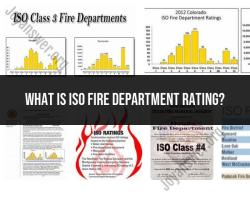What is ISO Fire Department rating?
ISO (Insurance Services Office) Fire Department ratings, often referred to as ISO ratings, are a system used to assess and evaluate the quality and effectiveness of a community's fire protection services. These ratings are typically used by insurance companies to determine insurance premiums for properties in a given area. The ISO rating system assesses various aspects of a community's fire protection capabilities. The lower the ISO rating, the better the fire protection services are considered to be.
ISO Fire Department ratings are based on several key factors, including:
Fire Department: This assesses the fire department's staffing levels, training, equipment, and overall effectiveness in responding to fires and emergencies.
Water Supply: The ISO evaluates the availability and adequacy of the water supply for firefighting purposes, including the condition and maintenance of fire hydrants and water sources.
Emergency Communications: This factor evaluates the community's 911 system, including its effectiveness in dispatching emergency responders and communication capabilities between the fire department and other agencies.
Community Risk Reduction: ISO assesses efforts to reduce the risk of fires through programs, inspections, and public education.
ISO ratings are expressed on a scale from 1 to 10, with 1 being the best rating and 10 indicating that the area has little or no recognized fire protection. Most communities aim to achieve a lower ISO rating, as it can result in lower insurance premiums for property owners. However, achieving a low ISO rating can be challenging and typically requires a well-equipped and well-trained fire department, an adequate and reliable water supply, and effective emergency communication systems.
Property owners can contact their local fire department or insurance provider to inquire about the ISO rating for a specific area. It's important to note that ISO ratings can change over time as a community's fire protection services improve or decline, so it's a good practice for property owners to stay informed about these ratings and how they may affect their insurance costs.
Understanding ISO Fire Department Ratings
The Insurance Services Office (ISO) is a nonprofit organization that provides property insurance companies with information and services to help them assess risk and set rates. One of the services that ISO provides is fire department ratings.
ISO fire department ratings are a measure of a fire department's ability to protect property from fire. The ratings are based on a scale of 1 to 10, with 1 being the best and 10 being the worst. A rating of 1 indicates that a fire department has excellent fire protection capabilities, while a rating of 10 indicates that a fire department has poor fire protection capabilities.
The Significance of Fire Department Ratings
ISO fire department ratings are significant because they can impact the cost of homeowners insurance. Insurance companies typically offer lower rates to homeowners in communities with higher ISO fire department ratings.
In addition, ISO fire department ratings can be used to assess the overall fire safety of a community. A community with a high ISO fire department rating is generally considered to be a safer place to live than a community with a low ISO fire department rating.
Factors Impacting ISO Fire Department Ratings
ISO fire department ratings are based on a variety of factors, including:
- The number of firefighters in the department
- The training and experience of the firefighters
- The quality of the fire department's equipment
- The water supply in the community
- The fire department's response times
- The community's fire prevention programs
Improving Fire Department Ratings for Communities
There are a number of things that communities can do to improve their ISO fire department ratings, including:
- Increasing the number of firefighters in the department
- Providing firefighters with regular training
- Investing in high-quality fire department equipment
- Improving the community's water supply
- Reducing fire response times
- Implementing fire prevention programs
Safety, Preparedness, and ISO Fire Ratings
ISO fire department ratings are an important factor to consider when assessing the safety and preparedness of a community. A community with a high ISO fire department rating is generally considered to be a safer place to live than a community with a low ISO fire department rating.
However, it is important to note that ISO fire department ratings are just one measure of a community's fire safety and preparedness. There are other factors that can also impact safety and preparedness, such as the community's building codes and the availability of fire insurance.
Homeowners and businesses can take steps to improve their own safety and preparedness, regardless of their community's ISO fire department rating. These steps include:
- Having a fire escape plan
- Installing smoke alarms and carbon monoxide detectors
- Keeping fire extinguishers on hand
- Maintaining a clear path to exits
- Storing flammable materials safely
By taking these steps, homeowners and businesses can help to reduce their risk of fire and improve their safety.


